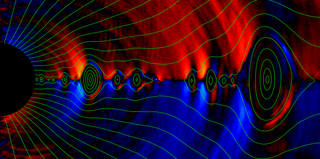'Balding' black holes prove Einstein right again on general relativity

A new physics breakthrough shows how Einstein's theory of general relativity continues to hold up, even for "balding" black holes.
Black holes are regions of spacetime where gravity's pull is so strong that nothing, not even light, can escape from being dragged in and "eaten." Einstein's theory of general relativity predicted the existence of black holes and that, no matter what such an object "eats," black holes are characterized only by their mass, spin and electrical charge. Astrophysicists refer to this as the "no-hair" theorem.
But there has been a lingering snag to this theorem: magnetic fields. For the no-hair theorem to hold true, "eating" material shouldn't alter a black hole's primary characteristics. But while black holes can be "born" with strong magnetic fields, they can also gain them by "eating" certain material and clouds of plasma can sustain these magnetic fields around a black hole.
Physicists investigated this snag by using a supercomputer to simulate a black hole surrounded by plasma. In this study, they found that even when black holes have sustained magnetic fields, the "no-hair" theorem, and Einstein's theory, continue to hold true.
Related: What happens at the center of a black hole?
"The no-hair conjecture is a cornerstone of general relativity," study co-author Bart Ripperda, a research fellow at the Flatiron Institute's Center for Computational Astrophysics (CCA) in New York City and a postdoctoral fellow at Princeton University in New Jersey, said in a statement. "If a black hole has a long-lived magnetic field, then the no-hair conjecture is violated. Luckily a solution came from plasma physics that saved the no-hair conjecture from being broken."
In their simulations, the researchers found that magnetic fields around black holes can evolve. Their simulation showed that magnetic field lines around the black hole would quickly break apart and reconnect. This phenomenon created pockets of plasma, energized by the magnetic field, that would bubble up and either be ejected out into space or swallowed up by the black hole.
Get the Space.com Newsletter
Breaking space news, the latest updates on rocket launches, skywatching events and more!
Related: Black holes of the universe (images)
"Theorists didn't think of this because they usually put their black holes in a vacuum," Ripperda says. "But in real life, there's often plasma, and plasma can sustain and bring in magnetic fields. And that has to fit with your no-hair conjecture."
What really rescued the no-hair theorem, however, is that the scientists found that this process quite quickly drained the magnetic field until it completely faded away.
This depletion happened very fast: a rate of 10% the speed of light.
"The fast reconnection saved the no-hair conjecture," Ripperda said.
This work is described in a study that was published July 27 in the journal Physical Review Letters.
Email Chelsea Gohd at cgohd@space.com or follow her on Twitter @chelsea_gohd. Follow us on Twitter @Spacedotcom and on Facebook.
Join our Space Forums to keep talking space on the latest missions, night sky and more! And if you have a news tip, correction or comment, let us know at: community@space.com.

Chelsea “Foxanne” Gohd joined Space.com in 2018 and is now a Senior Writer, writing about everything from climate change to planetary science and human spaceflight in both articles and on-camera in videos. With a degree in Public Health and biological sciences, Chelsea has written and worked for institutions including the American Museum of Natural History, Scientific American, Discover Magazine Blog, Astronomy Magazine and Live Science. When not writing, editing or filming something space-y, Chelsea "Foxanne" Gohd is writing music and performing as Foxanne, even launching a song to space in 2021 with Inspiration4. You can follow her on Twitter @chelsea_gohd and @foxannemusic.










